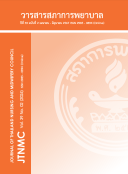Factors Influencing Low Muscle Strength among Community-Dwelling Older Adults with Non-Communicable Diseases
DOI:
https://doi.org/10.60099/jtnmc.v39i02.268466Keywords:
low muscle strength, age, physical activity, older adults, non-communicable diseases, communityAbstract
Introduction The presence of low muscle strength serves as a major indicator of sarcopenia and health status in older adults with non-communicable diseases (NCDs), leading to increased morbidity and mortality among them.
Objective 1) To describe the prevalence of low muscle strength, and 2) To investigate personal and health factors predicting low muscle strength in community-dwelling older adults with NCDs
Design This study employed a correlational predictive design, guided by physiological theory and literature as its conceptual framework.
Methodology The participants consisted of 192 community-dwelling older adults diagnosed with non-communicable diseases in Samut Prakan province. Purposive sampling was employed according to the inclusion and exclusion criteria. Data were collected using the Global Physical Activity Questionnaire (GPAQ) version 2, the Thai Geriatric Depression Scale (TGDS-15), and nutritional and muscle strength assessments. Data were then analyzed using descriptive statistics and logistic regression analysis.
Results Most of the participants were female (65.1%), with a mean age of 69.60 years (SD = 7.60). The prevalence of low muscle strength among older adults with non-communicable diseases was 54.17%. Personal and health factors including age (OR= 3.47, 95% CI = 1.91-6.33), weight loss (OR= 4.05, 95% CI = 1.11-14.70), physical activity (OR= 0.37, 95% CI = .19-.73), and depression (OR= 3.06, 95% CI = 1.16-8.03) were significantly predicted low muscle strength. Multiple logistic regression analysis revealed that age (OR= 3.02, 95%CI = 1.63-5.59) and physical activity (OR= 0.48, 95%CI = 0.24-0.97) together could predict low muscle strength among older adults with NCDs, accounting for 14.3% of the variance.
Recommendation This study demonstrates that age and physical activity significantly predict low muscle strength among older adults with NCDs in the community. Therefore, health promotion programs addressing physical activity should be developed to reduce risk factors and to prevent and delay sarcopenia particularly in older adults of advanced age with NCDs.
Downloads
References
Volaklis KA, Halle M, Meisinger C. Muscular strength as a strong predictor of mortality: a narrative review. Eur J Intern Med. 2015;26(5):303-10. https://doi.org/10.1016/j.ejim.2015.04.013 PMID: 25921473
Chen LK, Woo J, Assantachai P, Auyeung TW, Chou MY, Iijima K, et al. Asian Working Group for Sarcopenia: 2019 consensus update on sarcopenia diagnosis and treatment. J Am Med Dir Assoc. 2020;21(3):300-7.e2. https://doi.org/10.1016/j.jamda.2019.12.012 PMID: 32033882
Lino VT, Rodrigues NC, O’Dwyer G, Andrade MK, Mattos IE, Portela MC. Handgrip strength and factors associated in poor elderly assisted at a primary care unit in Rio de Janeiro, Brazil. PLoS ONE. 2016;11(11): e0166373. https://doi.org/10.1371/journal.pone.0166373 PMID: 27832209
de Araújo Amaral C, Amaral TLM, Monteiro GTR, de Vasconcellos MTL, Portela MC. Factors associated with low handgrip strength in older people: data of the Study of Chronic Diseases (Edoc-I). BMC Public Health. 2020;20(1):395. https://doi.org/10.1186/s12889-020-08504-z PMID: 32216788
Lim SK, Kong S. Prevalence, physical characteristics, and fall risk in older adults with and without possible sarcopenia. Aging Clin Exp Res. 2022;34(6):1365-71. https://doi.org/10.1007/s40520-022-02078-z PMID: 35133613
Tieland M, Trouwborst I, Clark BC. Skeletal muscle performance and ageing. J Cachexia Sarcopenia Muscle. 2018;9(1):3-19. https://doi.org/10.1002/jcsm.12238 PMID: 29151281
Bae EJ, Park NJ, Sohn HS, Kim YH. Handgrip strength and all-cause mortality in middle-aged and older Koreans. Int J Environ Res Public Health. 2019;16(5). https://doi.org/10.3390/ijerph16050740 PMID: 30823660
Pérez-Sousa MÁ, Pozo-Cruz Jd, Cano-Gutiérrez CA, Izquierdo M, Ramírez-Vélez R. High prevalence of probable sarcopenia in a representative sample from Colombia: implications for geriatrics in Latin America. J Am Med Dir Assoc. 2021;22(4):859-64. e1. https://doi.org/10.1016/j.jamda.2020.10.021 PMID: 33197411
Jiaqin Y, Yaoting W, Lin Y, Mengting R, Lingyan L, Hongyu W. Prevalence of possible sarcopenia in communitydwelling older Chinese adults: a cross-sectional study. BMJ Open. 2022;12(12):e067425. https://doi.org/10.1136/bmjopen-2022-067425 PMID: 36517096
Whaikit P, Kittipimpanon K, Piaseu N. Prevalence and predictors of sarcopenia among older Buddhist monks in Thailand. Pacific Rim International Journal of Nursing Research. 2020;24(3):363-75. Available from: https://he02.tci-thaijo.org/index.php/PRIJNR/article/view/214107/165354
Wiriya B, Piaseu N, Neelapaichit N, Tantiprasoplap S. Prevalence and predictors of sarcopenia in older people with type 2 diabetes. Pacific Rim International Journal of Nursing Research. 2019;23(3):297-309. Available from: https://he02.tci-thaijo.org/index.php/PRIJNR/article/view/166204/136248
Sternäng O, Reynolds CA, Finkel D, Ernsth-Bravell M, Pedersen NL, Dahl Aslan AK. Factors associated with grip strength decline in older adults. Age Ageing. 2015;44(2):269-74. https://doi.org/10.1093/ageing/afu170 PMID: 25362503
Shah SA, Safian N, Mohammad Z, Nurumal SR, Wan Ibadullah WAH, Mansor J, et al. Factors associated with handgrip strength among older adults in Malaysia. J Multidiscip Healthc. 2022;15:1023-34. https://doi.org/10.2147/JMDH.S363421 PMID: 35586078
Li D, Guo G, Xia L, Yang X, Zhang B, Liu F, et al. Relative handgrip strength is inversely associated with metabolic profile and metabolic disease in the general population in China. Front Physiol. 2018;9:59. https://doi.org/10.3389/fphys.2018.00059 PMID: 2945983
Yorke AM, Curtis AB, Shoemaker M, Vangsnes E. The impact of multimorbidity on grip strength in adults age 50 and older: data from the health and retirement survey (HRS). Arch Gerontol Geriatr. 2017;72: 164-8. https://doi.org/10.1016/j.archger.2017.05.011 PMID: 28667843
Kawamoto R, Ninomiya D, Kasai Y, Kusunoki T, Ohtsuka N, Kumagi T, et al. Handgrip strength is associated with metabolic syndrome among middle-aged and elderly community-dwelling persons. Clin Exp Hypertens. 2016;38(2):245-51. https://doi.org/10.3109/10641963.2015.1081232 PMID: 268 18203
Ashdown-Franks G, Stubbs B, Koyanagi A, Schuch F, Firth J, Veronese N, et al. Handgrip strength and depression among 34,129 adults aged 50 years and older in six low- and middle-income countries. J Affect Disord. 2019;243:448-54. https://doi.org/doi:10.1016/j.jad.2018.09.036 PMID: 30273883
Ferraro E, Pin F, Gorini S, Pontecorvo L, Ferri A, Mollace V, et al. Improvement of skeletal muscle performance in ageing by the metabolic modulator trimetazidine. J Cachexia Sarcopenia Muscle. 2016; 7(4):449-57. https://doi.org/10.1002/jcsm.12097 PMID: 27239426
Chong H, Choi YE, Kong JY, Park JH, Yoo HJ, Byeon JH, et al. Association of hand grip strength and cardiometabolic markers in Korean adult population: The Korea National Health and Nutrition Examination Survey 2015-2016. Korean J Fam Med. 2020;41(5): 291-8. https://doi.org/10.4082/kjfm.18.0129 PMID: 32380799
Dieli-Conwright CM, Spektor TM, Rice JC, Todd Schroeder E. Oestradiol and SERM treatments influence oestrogen receptor coregulator gene expression in human skeletal muscle cells. Acta Physiol (Oxf). 2009;197(3):187-96. https://doi.org/10.1111/j.1748-1716.2009.01997
PMID: 19432593
Cohen J. Statistical power analysis for the behavioral sciences. 2nd ed. Hillsdale,NJ: Lawrence Erlbaum Associates; 1998.
Jitapunkul S. Principles of geriatric medicine. In: Jitapunkul S, editor. Analysis of geriatric medicine. Bangkok: ChulalongkornUniversity. 1998:88-89. (in Thai)
Aekplakorn W, editor. The Fifth Thai National Health Examination Survey (NHES V). Nonthaburi, TH: Health Systems Research Institute. 2014. (in Thai)
Shiekh J, Yesavage J. Geriatric Depression Scale; recent findings and development of a short version. Clinical gerontology: a guide to assessment and intervention. New York: Howarth Press; 1986.
Wongpakaran N, Wongpakaran T. Prevalence of major depressive disorders and suicide in long-term care facilities: a report from northern Thailand. Psychogeriatrics. 2012 Mar;12(1):11-7. https://doi.org/10.1111/j.1479-8301.2011.00383.x PMID: 22416824
Wiśniowska-Szurlej A, Ćwirlej-Sozańska A, Kilian J, Wołoszyn N, Sozański B, Wilmowska-Pietruszyńska A. Reference values and factors associated with hand grip strength among older adults living in southeastern Poland. Scientific Reports. 2021;11(1):9950. https://doi.org/10.1038/s41598-021-89408-9 PMID: 33976319
Santarpia L, Contaldo F, Pasanisi F. Body composition changes after weight-loss interventions for overweight and obesity. Clin Nutr. 2013;32(2):157-61. https://doi.org/10.1016/j.clnu.2012.08.016 PMID: 22981240
Xie L, Jiang J, Fu H, Zhang W, Yang L, Yang M. Malnutrition in relation to muscle mass, muscle quality, and muscle strength in hospitalized older adults. J Am Med Dir Assoc. 2022;23(5):722-8. https://doi.org/10.1016/j.jamda.2021.11.025 PMID: 34953766
Robinson S, Granic A, Sayer AA. Nutrition and muscle strength, as the key component of sarcopenia: an overview of current evidence. Nutrients. 2019;11(12). https://doi.org/10.3390/nu11122942 PMID: 31817048
Wen Z, Gu J, Chen R, Wang Q, Ding N, Meng L, et al. Handgrip strength and muscle quality: results from the National Health and Nutrition Examination Survey database. Journal of Clinical Medicine. 2023;12(9): 3184. https://doi.org/10.3390/jcm12093184 PMID: 37176623
Wearing J, Konings P, Stokes M, de Bruin ED. Handgrip strength in old and oldest old Swiss adults – a crosssectional study. BMC Geriatrics. 2018;18(1):266. https://doi.org/10.1186/s12877-018-0959-0 PMID: 30400825
Haider S, Grabovac I, Dorner TE. Effects of physical activity interventions in frail and prefrail communitydwelling people on frailty status, muscle strength, physical performance and muscle mass- a narrative review. Wiener klinische Wochenschrift. 2019;131(11): 244-54. https://doi.org/10.1007/s00508-019-1484-7 PMID: 30941525
Zasadzka E, Pieczyńska A, Trzmiel T, Kleka P, Pawlaczyk M. Correlation between handgrip strength and depression in older adults- a systematic review and a meta-analysis. International journal of environmental research and public health. 2021; 18(9):4823. https://doi.org/10.3390/ijerph18094823 PMID: 33946502
Downloads
Published
How to Cite
Issue
Section
License
Copyright (c) 2024 The Journal of Thailand Nursing and Midwifery Council

This work is licensed under a Creative Commons Attribution-NonCommercial-NoDerivatives 4.0 International License.







